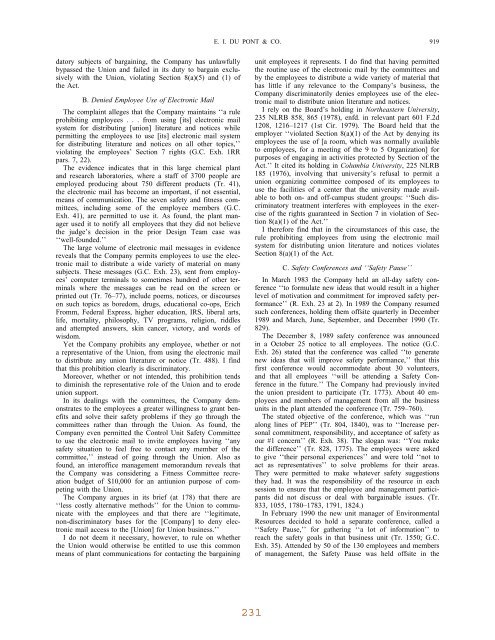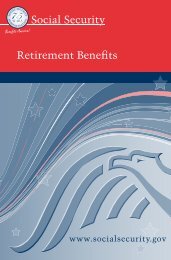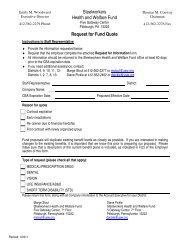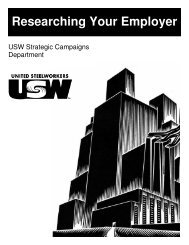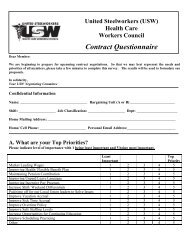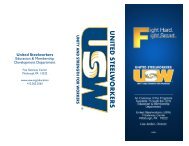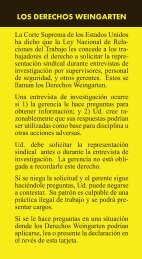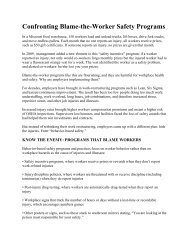Union Approach to Health and Safety: - United Steelworkers
Union Approach to Health and Safety: - United Steelworkers
Union Approach to Health and Safety: - United Steelworkers
You also want an ePaper? Increase the reach of your titles
YUMPU automatically turns print PDFs into web optimized ePapers that Google loves.
E. I. DU PONT & CO.<br />
919<br />
da<strong>to</strong>ry subjects of bargaining, the Company has unlawfully<br />
bypassed the <strong>Union</strong> <strong>and</strong> failed in its duty <strong>to</strong> bargain exclusively<br />
with the <strong>Union</strong>, violating Section 8(a)(5) <strong>and</strong> (1) of<br />
the Act.<br />
B. Denied Employee Use of Electronic Mail<br />
The complaint alleges that the Company maintains ‘‘a rule<br />
prohibiting employees . . . from using [its] electronic mail<br />
system for distributing [union] literature <strong>and</strong> notices while<br />
permitting the employees <strong>to</strong> use [its] electronic mail system<br />
for distributing literature <strong>and</strong> notices on all other <strong>to</strong>pics,’’<br />
violating the employees’ Section 7 rights (G.C. Exh. 1RR<br />
pars. 7, 22).<br />
The evidence indicates that in this large chemical plant<br />
<strong>and</strong> research labora<strong>to</strong>ries, where a staff of 3700 people are<br />
employed producing about 750 different products (Tr. 41),<br />
the electronic mail has become an important, if not essential,<br />
means of communication. The seven safety <strong>and</strong> fitness committees,<br />
including some of the employee members (G.C.<br />
Exh. 41), are permitted <strong>to</strong> use it. As found, the plant manager<br />
used it <strong>to</strong> notify all employees that they did not believe<br />
the judge’s decision in the prior Design Team case was<br />
‘‘well-founded.’’<br />
The large volume of electronic mail messages in evidence<br />
reveals that the Company permits employees <strong>to</strong> use the electronic<br />
mail <strong>to</strong> distribute a wide variety of material on many<br />
subjects. These messages (G.C. Exh. 23), sent from employees’<br />
computer terminals <strong>to</strong> sometimes hundred of other terminals<br />
where the messages can be read on the screen or<br />
printed out (Tr. 76–77), include poems, notices, or discourses<br />
on such <strong>to</strong>pics as boredom, drugs, educational co-ops, Erich<br />
Fromm, Federal Express, higher education, IRS, liberal arts,<br />
life, mortality, philosophy, TV programs, religion, riddles<br />
<strong>and</strong> attempted answers, skin cancer, vic<strong>to</strong>ry, <strong>and</strong> words of<br />
wisdom.<br />
Yet the Company prohibits any employee, whether or not<br />
a representative of the <strong>Union</strong>, from using the electronic mail<br />
<strong>to</strong> distribute any union literature or notice (Tr. 488). I find<br />
that this prohibition clearly is discrimina<strong>to</strong>ry.<br />
Moreover, whether or not intended, this prohibition tends<br />
<strong>to</strong> diminish the representative role of the <strong>Union</strong> <strong>and</strong> <strong>to</strong> erode<br />
union support.<br />
In its dealings with the committees, the Company demonstrates<br />
<strong>to</strong> the employees a greater willingness <strong>to</strong> grant benefits<br />
<strong>and</strong> solve their safety problems if they go through the<br />
committees rather than through the <strong>Union</strong>. As found, the<br />
Company even permitted the Control Unit <strong>Safety</strong> Committee<br />
<strong>to</strong> use the electronic mail <strong>to</strong> invite employees having ‘‘any<br />
safety situation <strong>to</strong> feel free <strong>to</strong> contact any member of the<br />
committee,’’ instead of going through the <strong>Union</strong>. Also as<br />
found, an interoffice management memor<strong>and</strong>um reveals that<br />
the Company was considering a Fitness Committee recreation<br />
budget of $10,000 for an antiunion purpose of competing<br />
with the <strong>Union</strong>.<br />
The Company argues in its brief (at 178) that there are<br />
‘‘less costly alternative methods’’ for the <strong>Union</strong> <strong>to</strong> communicate<br />
with the employees <strong>and</strong> that there are ‘‘legitimate,<br />
non-discrimina<strong>to</strong>ry bases for the [Company] <strong>to</strong> deny electronic<br />
mail access <strong>to</strong> the [<strong>Union</strong>] for <strong>Union</strong> business.’’<br />
I do not deem it necessary, however, <strong>to</strong> rule on whether<br />
the <strong>Union</strong> would otherwise be entitled <strong>to</strong> use this common<br />
means of plant communications for contacting the bargaining<br />
unit employees it represents. I do find that having permitted<br />
the routine use of the electronic mail by the committees <strong>and</strong><br />
by the employees <strong>to</strong> distribute a wide variety of material that<br />
has little if any relevance <strong>to</strong> the Company’s business, the<br />
Company discrimina<strong>to</strong>rily denies employees use of the electronic<br />
mail <strong>to</strong> distribute union literature <strong>and</strong> notices.<br />
I rely on the Board’s holding in Northeastern University,<br />
235 NLRB 858, 865 (1978), enfd. in relevant part 601 F.2d<br />
1208, 1216–1217 (1st Cir. 1979). The Board held that the<br />
employer ‘‘violated Section 8(a)(1) of the Act by denying its<br />
employees the use of [a room, which was normally available<br />
<strong>to</strong> employees, for a meeting of the 9 <strong>to</strong> 5 Organization] for<br />
purposes of engaging in activities protected by Section of the<br />
Act.’’ It cited its holding in Columbia University, 225 NLRB<br />
185 (1976), involving that university’s refusal <strong>to</strong> permit a<br />
union organizing committee composed of its employees <strong>to</strong><br />
use the facilities of a center that the university made available<br />
<strong>to</strong> both on- <strong>and</strong> off-campus student groups: ‘‘Such discrimina<strong>to</strong>ry<br />
treatment interferes with employees in the exercise<br />
of the rights guaranteed in Section 7 in violation of Section<br />
8(a)(1) of the Act.’’<br />
I therefore find that in the circumstances of this case, the<br />
rule prohibiting employees from using the electronic mail<br />
system for distributing union literature <strong>and</strong> notices violates<br />
Section 8(a)(1) of the Act.<br />
C. <strong>Safety</strong> Conferences <strong>and</strong> ‘‘<strong>Safety</strong> Pause’’<br />
In March 1983 the Company held an all-day safety conference<br />
‘‘<strong>to</strong> formulate new ideas that would result in a higher<br />
level of motivation <strong>and</strong> commitment for improved safety performance’’<br />
(R. Exh. 23 at 2). In 1989 the Company resumed<br />
such conferences, holding them offsite quarterly in December<br />
1989 <strong>and</strong> March, June, September, <strong>and</strong> December 1990 (Tr.<br />
829).<br />
The December 8, 1989 safety conference was announced<br />
in a Oc<strong>to</strong>ber 25 notice <strong>to</strong> all employees. The notice (G.C.<br />
Exh. 26) stated that the conference was called ‘‘<strong>to</strong> generate<br />
new ideas that will improve safety performance,’’ that this<br />
first conference would accommodate about 30 volunteers,<br />
<strong>and</strong> that all employees ‘‘will be attending a <strong>Safety</strong> Conference<br />
in the future.’’ The Company had previously invited<br />
the union president <strong>to</strong> participate (Tr. 1773). About 40 employees<br />
<strong>and</strong> members of management from all the business<br />
units in the plant attended the conference (Tr. 759–760).<br />
The stated objective of the conference, which was ‘‘run<br />
along lines of PEP’’ (Tr. 804, 1840), was <strong>to</strong> ‘‘Increase personal<br />
commitment, responsibility, <strong>and</strong> acceptance of safety as<br />
our #1 concern’’ (R. Exh. 38). The slogan was: ‘‘You make<br />
the difference’’ (Tr. 828, 1775). The employees were asked<br />
<strong>to</strong> give ‘‘their personal experiences’’ <strong>and</strong> were <strong>to</strong>ld ‘‘not <strong>to</strong><br />
act as representatives’’ <strong>to</strong> solve problems for their areas.<br />
They were permitted <strong>to</strong> make whatever safety suggestions<br />
they had. It was the responsibility of the resource in each<br />
session <strong>to</strong> ensure that the employee <strong>and</strong> management participants<br />
did not discuss or deal with bargainable issues. (Tr.<br />
833, 1055, 1780–1783, 1791, 1824.)<br />
In February 1990 the new unit manager of Environmental<br />
Resources decided <strong>to</strong> hold a separate conference, called a<br />
‘‘<strong>Safety</strong> Pause,’’ for gathering ‘‘a lot of information’’ <strong>to</strong><br />
reach the safety goals in that business unit (Tr. 1550; G.C.<br />
Exh. 35). Attended by 50 of the 130 employees <strong>and</strong> members<br />
of management, the <strong>Safety</strong> Pause was held offsite in the


